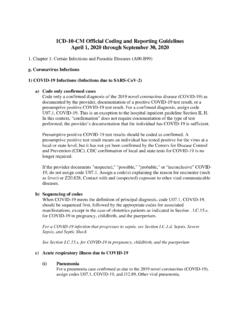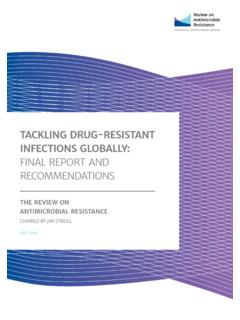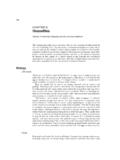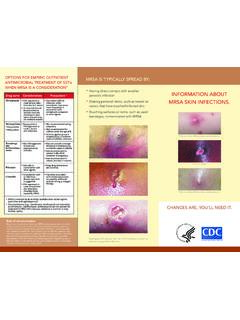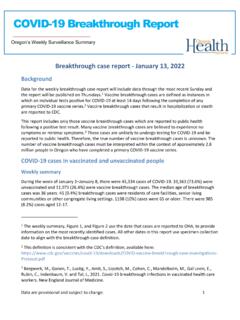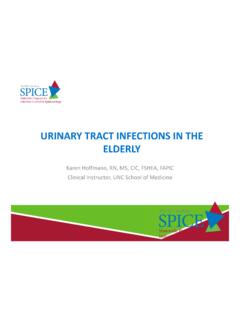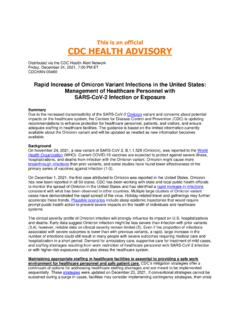Transcription of Guidance on the diagnosis and management of PVL …
1 Guidance on the diagnosis and management of PVL-associated Staphylococcusaureusinfections (PVL-SA) in EnglandReport prepared by the PVL sub-group of the Steering Group on Healthcare Associated Infection 1 Guidance on the diagnosis and management of PVL-associated Staphylococcus aureus infections (PVL-SA) in England, 2nd Edition. Second Edition: 7 November 2008 First Edition published: 15 August 2008 Cover Staphylococcus aureus image: CDC/ Janice Haney Carr/ Jeff Hageman, 2 CONTENTS 1. Background 4 Clinical features of PVL-SA 5 Skin and soft tissue infections 6 Invasive infections 6 Risk factors for PVL-SA 6 When to suspect PVL-SA infection 8 2.
2 Microbiological Sampling 8 Microbiological testing of clinical samples 8 PVL testing 8 Microbiological testing of screening samples 10 Suspected outbreaks 10 Antimicrobial susceptibility testing 10 3. management of cases 10 Skin and soft tissue infections 10 General care 10 When antimicrobials are indicated for skin and soft tissue infection 12 Community-acquired necrotising pneumonia 12 Clinical management of necrotising pneumonia (mainly supportive) 13 Antimicrobial therapy of necrotising pneumonia 13 Adjunctive therapy with Intravenous Immunoglobulin (IVIG) in necrotising pneumonia 15 Osteomyelitis and other deep-seated infections 15 Investigations 15 Therapy of osteomyelitis and other deep-seated infections 15 Special consideration of infections in children 16 Skin and soft tissue infections in children 16 Deep-seated infections in children 16 4.
3 Decolonization and screening of patients and their close contacts 18 Principles of decolonization 18 Decolonization of infected patients 19 Screening and decolonization of contacts 19 Decolonization of family contacts of a case of necrotising pneumonia 20 Clusters of PVL-SA infection in the community 20 Care homes and residential facilities, including prisons and barracks 20 Nurseries and schools 20 Gyms and sports facilities 21 5. Infection prevention and control in hospital and the community 21 Infection prevention and control for hospitalised patients 21 Community-acquired infections 21 Hospital-acquired infections 21 Occupational Health 22 Infection prevention and control for affected people in the community 22 6.
4 Surveillance 23 Appendices Appendix 1 PVL-Staphylococcus aureus information for patients 24 Appendix 2 Decolonization procedure for PVL-Staphylococcus aureus: how to use the decolonization preparations 28 Appendix 3 Guidance for reducing the spread of PVL-Staphylococcus aureus in communal and other recreational settings 30 Appendix 4 Guidance for reducing the spread of PVL-Staphylococcus aureus (PVL-SA) in schools and nurseries 34 Appendix 5 Advice for managers of care homes to help reduce spread of PVL- Staphylococcus aureus 36 Appendix 6 Guidance for the screening and treatment of PVL-Staphylococcus aureus for Primary Care 38 Appendix 7 - Special consideration of infections in children 40 Membership of the sub-group and acknowledgements 42 Glossary 44 References
5 46 4 Guidance on the diagnosis and management of PVL-associated Staphylococcus aureus infections (PVL-SA) in England This Guidance was prepared by a sub-group of the Steering Group on Healthcare Associated infections (SG-HCAI) at the request of the Department of Health and replaces that drafted by Health Protection Agency (HPA) working group in 2006. It is based on expert opinion following review of the literature and experiences of colleagues in the UK, Europe, the USA and Canada. There is little hard research evidence to support this Guidance , particularly with reference to screening and decolonization.
6 Existing international Guidance and expert opinion range from a highly proactive search and destroy approach to a more pragmatic, reactive approach. This Guidance tries to steer a course between these, based on risk assessment of the situation and will be updated as developments in the field occur. This Guidance is intended to provide healthcare professionals with easily accessible advice on the recognition, investigation and management of PVL-Staphylococcus aureus (PVL-SA) cases. Guidance on the diagnosis and management of meticillin-resistant Staphylococcus aureus (MRSA) infections presenting in the community1 has been produced by the British Society for Antimicrobial Chemotherapy (BSAC) to supplement existing MRSA guidelines at the request of the Specialist Advisory Committee on Antimicrobial Resistance (SACAR) and there has been close collaboration and joint membership between the sub-groups to ensure that Guidance in areas of overlap is consistent.
7 1. Background Panton-Valentine Leukocidin (PVL) is a toxin that destroys white blood cells and is a virulence factor in some strains of Staphylococcus aureus. Strains of PVL-SA producing a new pattern of disease have emerged in the UK and worldwide. In the UK the genes encoding for PVL are carried by < 2% of clinical isolates of S. aureus submitted to the national Reference Laboratory, whether meticillin-sensitive (MSSA) or meticillin-resistant (MRSA).2 While PVL is currently accepted as an important virulence factor in S. aureus, some recent publications call this into question. Alternatives such as the Arginine Catabolism Mobile Element (ACME), -toxin, regulation of gene expression, and/or newly described cytolytic peptides have been put forward to explain the pathogenicity associated with PVL-SA.
8 These bacterial aspects, in conjunction with host factors, are the subject of intense investigation and are key to furthering our understanding of the virulence of PVL-SA. Nevertheless, PVL has been strongly associated epidemiologically with virulent, transmissible strains of S. aureus, including community-associated (CA) MRSA. In summary, PVL remains a valuable marker and target for screening for virulence in some strains of S. aureus. 5 Strains of S. aureus encoding the PVL genes were recognised in the early 1900s in staphylococcal skin abscesses. In the 1950s and 60s, the phage type 80/81 strain spread widely.
9 This strain was PVL-positive (PVL-MSSA) and proved highly successful in the UK and abroad, causing widespread disease (most commonly boils and abscesses) in previously healthy individuals in the community, as well as in hospitalised patients and healthcare workers. The escalation in morbidity and mortality associated with PVL-MRSA has caused public health concern worldwide. To date most PVL-SA strains in the UK have been MSSA, but a major problem has emerged with CA-MRSA in North America, most of which produce PVL. One strain in particular, the USA300 clone, is now spreading in hospitals in the From a UK perspective, occasional fatalities due to PVL-SA and outbreaks in both community and healthcare settings have attracted high-profile media attention and prompted concern regarding the transmissibility and virulence sometimes associated with these organisms.
10 Following national alerts and improved case ascertainment initiatives, the HPA has been monitoring PVL-related disease throughout England and Wales. During 2005 and 2006, a total of 720 cases of PVL-SA were identified from isolates referred to the Reference Laboratory for testing and characterization. Of these, 224 were in 2005 and 496 in 2006, representing a two-fold increase. However, initiatives have been underway in this period to raise awareness of PVL-SA, so it is unclear how much of this increase is due to improved ascertainment. The majority of referred isolates were PVL-MSSA (444, 62%).










